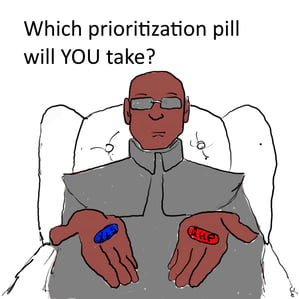Red Pill or Blue Pill: Fix Prioritization Now
Updated:
Published:

"You take the blue pill... the story ends, you wake up in your bed and believe whatever you want to believe. You take the red pill... you stay in Wonderland, and I show you how deep the rabbit hole goes." Morpheus, The Matrix
Are you living with a prioritization process that you know isn’t right? It’s painful, it’s wasteful, and we never quite deliver the strategy, but… people are keeping busy, we have a spreadsheet and the sales guy at the PPM vendor reckons his tool might help.
If this is your reality and you’re happy with it, then take the Blue Pill. You’ll wake up on Monday morning and the world will be just the same.
But if you’re tired of accepting mediocrity in prioritization then you need the Red Pill. The one that will show you that taking control of your portfolio is about making choices.
Select the right process for prioritization
One of the key tenets of leadership is knowing how to make the big calls. Striking the balance between gathering data and recognizing the right time to deliver action. Prioritizing a portfolio is exactly the same. Invest in systematic data collection, but don’t lose sight of the need to make a timely commitment to start delivery.
If you rush this process, you can end up with a model people don’t trust. If you take too long then finance have already locked budgets by the time you've identified investment requirements.
A well-structured plan is key. Changing the culture of how decisions are made won’t be easy but a tight schedule and leadership buy-in will see you through to delivery. The Red Pill will transform performance but only if you’re ready to make it work.
Making choices is hard, not making choices is weak
Inherent in planning a portfolio is making choices. In a commercial environment, consider the competing focus of quarterly earnings and strategic initiatives. Typically, performance bonuses tend to favor the former, while the heroes of industry are often the ‘big thinkers’ who deliver the latter. Growth versus profitability is also another challenging balance, which we currently see playing out in Big Tech, where excessive pursuit of growth during the pandemic has given way to making cuts that restore margins.
These choices are not exclusive to the private sector. In government choices mean determining the relative importance of competing interest groups. This could be Health vs. Education, or Leisure vs. Sanitation. The key point is there is never enough in the pot to do everything.
Not making these choices means wasting time developing plans that won’t get funded while portfolios fill up with projects that have been ‘signed-off’ without adequate resources to complete. Pet projects sneak in, and failing projects are never stopped. This is waste, and it makes up 20% of the average portfolio. Stopping this waste alone will represent a handsome ROI for any PMO who choses the Red Pill.
A Pairwise Review is key to making choices
The key to making choices is to articulate what they are, and then determine a quantifiable relationship between them. To do this we recommend a Decision Science discipline called AHP (Analytic Hierarchy Process), specifically a Pairwise review.
Inherent in this are ‘Criteria’ or high-level buckets that represent your portfolio’s competing goals. There is no such thing as a generic set of criteria, much in the way that no two organizations are identical. However, there are six key themes we see time and again:
Six Criteria to build a brilliant AHP model
When building your AHP model we recommend starting here:
- Near term objectives
Typically aligned to core KPIs, or quantifiable commitments such as service level agreements. Includes your CFO's favorites - revenue, margin & ROI. - Strategic objectives
Transformation goals and long-term market positioning fit here. Typically, very hard to quantify without a lot of assumptions. Ignore these at your peril. - Efficiency goals
Reduce a specific cost line, or reduce the need for future spending - productivity is key. Could be how you free up funding to drive growth when times are challenging. - Stakeholder impact
Increasingly companies are mindful of both their own people and their roles in the broader community, so add these considerations into your model. ESG fits here. - Risk reduction
Spend to stop something bad that might happen. It's very hard to value in an ROI model, but critical to find the right level of investment to address potential calamities. - Project delivery risk
Analyze projects’ likelihood to go wrong, then apply a discount to the value of high risk projects, meaning they must offer more value than safer bets.
Check out our Ultimate Guide to Criteria for more detail.
Are you ready to enter the Matrix?
We started out with a choice – Red Pill or Blue Pill. If you’re still committed to Red, then be ready for the challenge that will come next.
There’s good news. Building your AHP model is fun. It forces you to make reflective choices that, frankly, you should have made years ago. It gets colleagues to talk to one another to search out shared purpose. However, it does need time. Delivering a significant cultural change cannot happen in the last 15 minutes of a meeting.
There’s also going to be challenges. You’ll probably get pushback from people feeling threatened by change. Directors used to controlling their share of spending, Finance comfortable with their ROI model, or a C-Suiter who rather enjoyed being the Loudest Voice. You’ll need to convince them that they too have a choice – Red Pill or Blue Pill?
